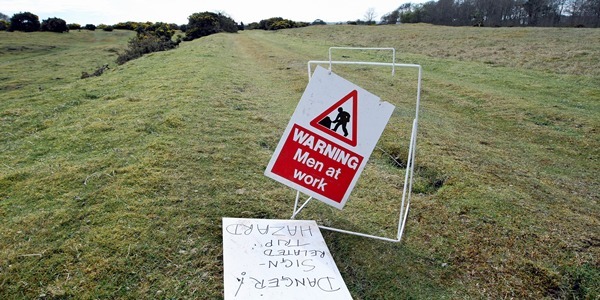Conservationists battling to save lizards from being crushed by diggers in Montrose have made a rare discovery which could raise the profile of Kinnaber as a “very special jewel in the Angus crown.”
Work had already started near to the viaduct when Mr Rose noticed that construction workers’ storage units had been placed on the Kinnaber Moor section of the planned cycle path.
Mr Rose contacted the council’s roads department and arranged to meet the engineer in charge of the works.
Plans revealed the proposed route for the cycle path was the line of the old railway, a raised embankment covered in gorse scrub, long since abandoned and now home to hundreds of common lizards. As common lizards are protected against intentional killing and injuring, the council was obliged to accommodate mitigation measures.
The use of refuges was discussed, as was the possibility of monitoring for lizard movements when the excavators move in.
Once work has started on the path, which is expected to cost around £1760 per year to maintain, the group will continue to monitor the site to capture any lizards that try to flee the construction work.
Kinnaber Moor is a site of around 200 hectares, with populations of common lizards throughout. The proposed cycle path only affects a narrow tract of habitat across the moor, but the old railway embankment is a key feature in the area.
“The resident lizards use the embankment as a hibernaculum and are just beginning to emerge at this time of year,” said Mr Rose.
“They will begin to disperse into the surrounding rank grass vegetation once it has grown on later in the year, but for now they are basking, feeding and preparing for courtship on and around the embankment.
“This is a very important feature on the landscape and the development is putting them at considerable risk. Common lizards are numerous in the Glens and foothills of the nearby Cairngorms, but are fragmented and rare on the lowlands and coastal areas.
“This population is one of only four that are known to FAH in Angus, are therefore very precious and need our protection.
“Our short-term and emergency plan is to capture as many lizards as possible and move them to other areas of the moor, suitably far away that they won’t migrate back before the work on the cycle path has finished.”
A volunteer found a slow-worm while embarking on a rescue mission to move lizards from the Kinnaber area on the outskirts of the town to land which will be unaffected by work on a £229,000 cycle path.
The slow-worm is a type of lizard. It looks like a snake in some respects but the fact that it has eyelids, a flat forked tongue and can drop its tail to escape from a predator gives its true identity away.
Trevor Rose from Friends of Angus Herpetofauna (FAH) said it was a “fantastic find.”
“If verified, this will be the only current record of slow-worm to the east of the A90,” he said. “Until now, all the records I have for Angus come from the Glens.
“Like the common lizards, slow-worms and adders would have had a much wider distribution historically, but lowland farming, particularly modern agriculture, has all but wiped them out, leaving them fragmented and isolated.
“I had previously believed that only common lizards had survived in a few suitable lowland locations, but if proven, this will show that slow-worms are hanging on in Kinnaber.
“This won’t help our case at Kinnaber as slow-worms are only afforded the same protection in law as common lizards, but it would certainly raise the profile of Kinnaber as a very special jewel in the Angus crown.”
The slow-worm can be found in almost any open or semi-open habitat. It likes warmth but instead of basking in the open sun it prefers to hide under a stone, log or piece of discarded rubbish such as a sheet of corrugated iron or plank of wood exposed to the sun.
Slow-worms are also keen on compost heaps where they find warmth and plenty of food. They feed on slow moving prey, particularly small slugs, and are protected by law in Britain against being killed, injured or sold or traded in any way.
The cycle path, linking Montrose to Northwater viaduct, cuts through common lizard habitat, one of the few remaining lowland populations of the species in Angus.
Continued…
